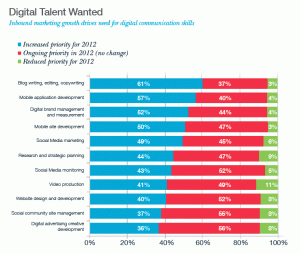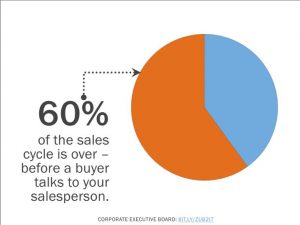What are the digital jobs of the future?
February 27, 2012

What digital talent will be in demand down the road?
Wondering where the marketing and digital marketing jobs will be down the road?
Look no further than this chart.
As you can see, content creators/writers are in huge demand right now. With the push to creating quality content, I don’t suspect this need will diminish any time soon.
I’m pleased and relieved to see that strategic planning/thinking is still in demand as well. I worry that too many companies will leap without looking simply because digital/social is easy and/or cheap. It doesn’t matter how fast you can climb a ladder if you’ve propped it against the wrong building.
Whether you’re a college student trying to decide how to direct your studies, a marketing professional thinking about course corrections or you’re responsible for hiring within your agency or corporation — this is your future. Better introduce yourself.
Note: This chart is part of the 2012 edition of The SoDA Report, from the Society of Digital Agencies.*
*If you haven’t heard of SoDA — the Society of Digital Agencies was created five years ago to advance the industry through best practices, education and advocacy. Their membership is made up of digital agencies and production companies throughout the world, on five continents in 24 countries.
They also have a Peer Collaboration Group program with 350 members across 12 disciplines.
For the last four years, they’ve done this research and produced the SoDA report. (click here to download the entire 96 page 2012 report)
In terms of who participate in the research: 53% of the participants were marketers representing corporate brands (25%), consumer brands (30%) and other related industries (45%). The remaining 47% were creative service leaders from traditional agencies (23%), digital agencies (64%) and production companies (13%).
Over 76% of respondents were key decision makers and influencers (CMOs, senior executives, VPs and directors) with annual marketing budgets ranging from under US$1M to over US$100M and whose key markets are North America (57%), Europe (19%) and APAC (11%).
More


















